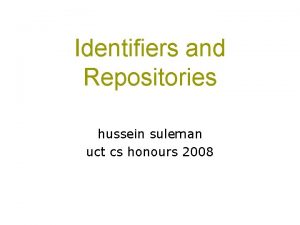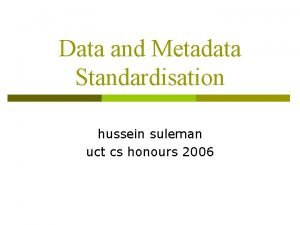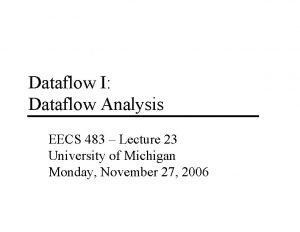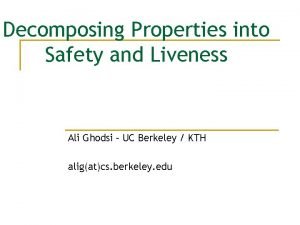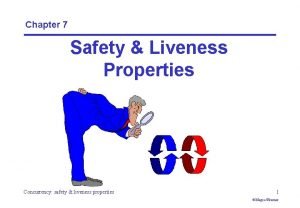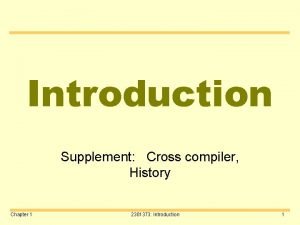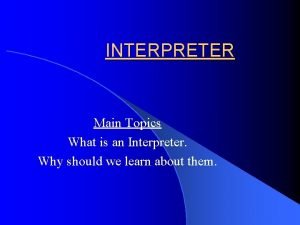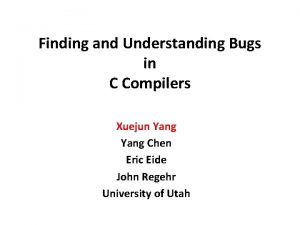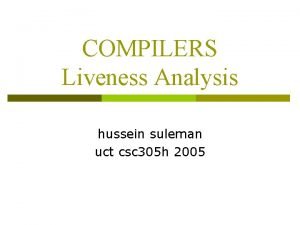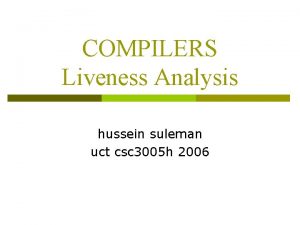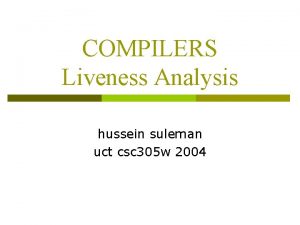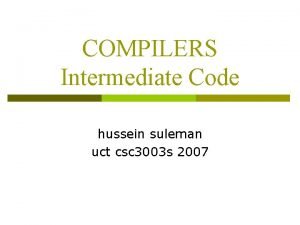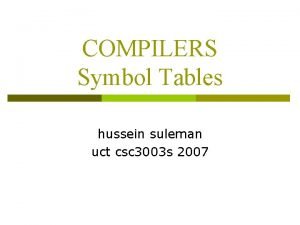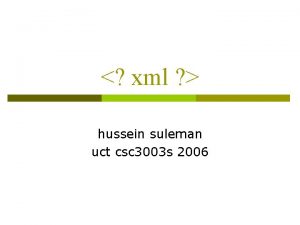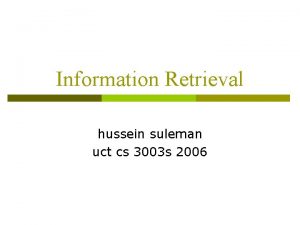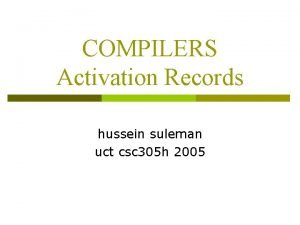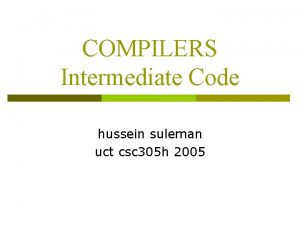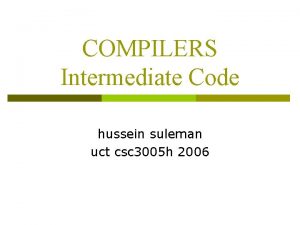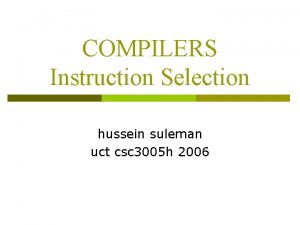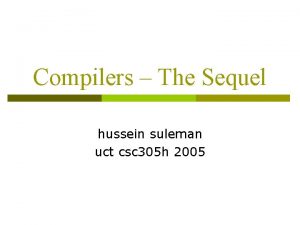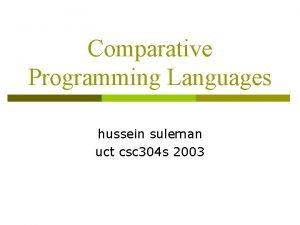COMPILERS Liveness Analysis hussein suleman uct csc 3003









![Calculating Liveness 2/3 p Define: n n p in[n]: variables live-in at n out[n]: Calculating Liveness 2/3 p Define: n n p in[n]: variables live-in at n out[n]:](https://slidetodoc.com/presentation_image_h/9707f28e897bfd977e37ade97a9857d9/image-10.jpg)
![Calculating Liveness 3/3 p Note: n n in[n] use[n] in[n] out[n] - def[n] use[n] Calculating Liveness 3/3 p Note: n n in[n] use[n] in[n] out[n] - def[n] use[n]](https://slidetodoc.com/presentation_image_h/9707f28e897bfd977e37ade97a9857d9/image-11.jpg)
![Iterative Liveness Calculation Algorithm foreach n {in[n] = {}; out[n] = {}} repeat foreach Iterative Liveness Calculation Algorithm foreach n {in[n] = {}; out[n] = {}} repeat foreach](https://slidetodoc.com/presentation_image_h/9707f28e897bfd977e37ade97a9857d9/image-12.jpg)





- Slides: 17

COMPILERS Liveness Analysis hussein suleman uct csc 3003 s 2007

Register Allocation IR trees are tiled to determine instructions, but registers are not assigned. p Can we assign registers arbitrarily? p What if: p mov d 0, 24 mov d 1, 36 add d 0, d 1 p was translated to: mov eax, 24 mov eax, 36 add eax, eax

Allocation Issues p Issues: n n p Registers already have previous values when they are used. But there a limited number of registers so we have to reuse! Use of particular registers affects which instructions to choose. Register vs. memory use affects the number and nature of LOAD/STORE instructions. Optimal allocation of registers is difficult. n NP-complete for k >1 registers

Liveness Analysis p Problem: n n p IR contains an unbounded number of temporaries. Actual machine has bounded number of registers. Approach: n n Temporaries with disjoint live ranges (where their values are needed) can map to same register. If not enough registers then spill some temporaries. p p [i. e. , keep them in memory] Liveness Analysis = determining when variables/registers hold values that may still be needed.

Control Flow Analysis p Before performing liveness analysis, we need to understand the control flow by building a control flow graph [CFG]: n n Nodes may be individual program statements or basic blocks. Edges represent potential flow of control. Out-edges from node n lead to successor nodes, succ[n]. p In-edges to node n come from predecessor nodes, pred[n]. p

Control Flow Example 1/2 p Sample Program L 1: a = 0 b = a + 1 c = c + b a = b * 2 if a < N goto L 1 return c

Control Flow Example 2/2 a=0 a=0 b=a+1 c=c+b a=b*2 a<N a<N return c a b return c c

def and use Gathering liveness information is a form of data flow analysis operating over the CFG. p Liveness of variables “flows” around the edges of the graph. p n assignments define a variable, v: def[v] set of graph nodes that define v p def[n] set of variables defined by node n p n occurrences of v in expressions use it: use[v] = set of nodes that use v p use[n] = set of variables used in node n p

Calculating Liveness 1/3 v is live on edge e if there is a directed path from e to a use of v that does not pass through any def[v]. p v is live-in at node n if live on any of n’s in -edges. p v is live-out at n if live on any of n’s outedges. p v use[n] => v live-in at n p v live-in at n => v live-out at all m pred[n] p v live-out at n, v def[n] => v live-in at n p
![Calculating Liveness 23 p Define n n p inn variables livein at n outn Calculating Liveness 2/3 p Define: n n p in[n]: variables live-in at n out[n]:](https://slidetodoc.com/presentation_image_h/9707f28e897bfd977e37ade97a9857d9/image-10.jpg)
Calculating Liveness 2/3 p Define: n n p in[n]: variables live-in at n out[n]: variables live-out at n Then: n n n out[n] = in[s] s succ[n] for a single node successor, p succ[n] = {} => out[n] = {}
![Calculating Liveness 33 p Note n n inn usen inn outn defn usen Calculating Liveness 3/3 p Note: n n in[n] use[n] in[n] out[n] - def[n] use[n]](https://slidetodoc.com/presentation_image_h/9707f28e897bfd977e37ade97a9857d9/image-11.jpg)
Calculating Liveness 3/3 p Note: n n in[n] use[n] in[n] out[n] - def[n] use[n] and def[n] are constant [independent of control flow] p Now, p v in[n] iff v use[n] or v out[n] def[n] p Thus, in[n] = use[n] [out[n] - def[n]] p
![Iterative Liveness Calculation Algorithm foreach n inn outn repeat foreach Iterative Liveness Calculation Algorithm foreach n {in[n] = {}; out[n] = {}} repeat foreach](https://slidetodoc.com/presentation_image_h/9707f28e897bfd977e37ade97a9857d9/image-12.jpg)
Iterative Liveness Calculation Algorithm foreach n {in[n] = {}; out[n] = {}} repeat foreach n in’[n] = in[n]; out’[n] = out[n]; in[n] = use[n] (out[n] - def[n]) out[n] = in[s] s succ[n] until n (in’[n] = in[n]) & (out’[n] = out[n])

Liveness Algorithm Notes p Should order computation of inner loop to follow the “flow”. n Liveness flows backward along control-flow arcs, from out to in. Nodes can just as easily be basic blocks to reduce CFG size. p Could do one variable at a time, from uses back to defs, noting liveness along the way. p

Liveness Algorithm Complexity 1/2 Complexity: for input program of size N p ≤ N nodes in CFG p => < N variables p => N elements per in/out p => O(N) time per set-union p for loop performs constant number of set operations per node p => O(N 2) time for loop p

Liveness Algorithm Complexity 2/2 Each iteration of repeat loop can only add to each set. p Sets can contain at most every variable p => sizes of all in and out sets sum to 2 N 2 , p bounding the number of iterations of the repeat loop p => worst-case complexity of O(N 4) p ordering can cut repeat loop down to 2 -3 iterations p => O(N) or O(N 2) in practice p

Optimality 1/2 p Least fixed points n n There is often more than one solution for a given dataflow problem (see example in text). Any solution to dataflow equations is a conservative approximation: p v has some later use downstream from n, § => v out(n) § but not the converse p What is the implication of a non-least-fixed -point?

Optimality 2/2 Conservatively assuming a variable is live does not break the program; just means more registers may be needed. p Assuming a variable is dead when it is really live will break things. p May be many possible solutions but want the “smallest”: the least fixed point. p The iterative liveness computation computes this least fixed point. p
 Uct computer science
Uct computer science Hussein suleman
Hussein suleman Hussein suleman
Hussein suleman Reporaproblem
Reporaproblem Hussein suleman
Hussein suleman Afi 36-3003
Afi 36-3003 Sonor drums history
Sonor drums history Eecs483
Eecs483 Suleman ahmer
Suleman ahmer Safety liveness
Safety liveness Safety and liveness in concurrency
Safety and liveness in concurrency Liveness detection
Liveness detection Safety vs liveness
Safety vs liveness Cs 421 uiuc
Cs 421 uiuc Binarymove compilers
Binarymove compilers Cousins of compiler
Cousins of compiler What is an interpreter
What is an interpreter Finding and understanding bugs in c compilers
Finding and understanding bugs in c compilers



